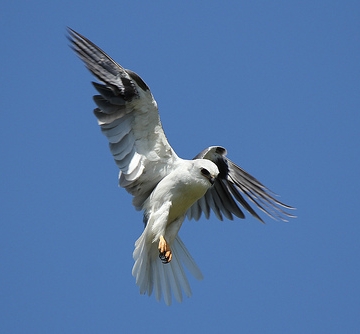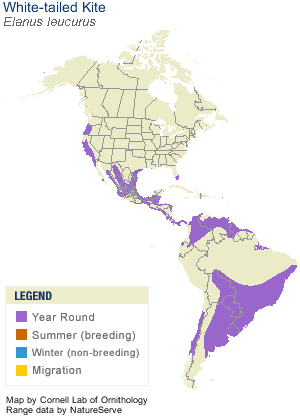
|
|
White-tailed Kite - Elanus leucurusOverviewThe White-tailed Kite, also referred to as the White Hawk and the Black-shouldered Kite, is the only North American Kite that hovers while hunting for prey. This prey consists of small rodents, especially Voles, and occasionally reptiles, insects, and other small birds. White-tailed Kites form monogamous pairs in December that last until August. Nests are built 20-50 feet high in trees and are often built near other pairs. About 4 eggs are laid and, after hatching, the male will hunt while the female stays with the nest. White-tailed Kites roost together when not breeding in groups of 5 to even 100 birds. California has the highest population in all of North America. Where to ViewBecause White-tailed Kites hover when hunting, they are found in areas with open fields with sparse trees such as in lowland grasslands, wetlands, oak-woodlands, savannas, riparian areas, and in agricultural areas. These are non-migratory birds that can be seen year round, but do tend to follow prey populations. They are often seen as they forage above the grassy stips along the freeways. They are commonly found by the Sacramento River, in the central valley, and the San Francisco Bay Area. White-tailed Kites can be easily spotted by their white plumage and hovering in open areas. The eBird Range Map has current information about White-tailed Kite locations in the Bay Area. White-tailed Kites can be seen relatively easily at several Bay Area parks including the following:
Conservation StatusThe White-tailed Kite was headed towards extinction in the 1930s due to habitat destruction, shooting, and egg collection. It was recorded in 1929, that there were 40 White-tailed Kites in the Santa Clara Valley, but by 1931 there were only a few left in the area. In the late 1950s, the White-tailed Kite was fully protected and numbers began to rise due to an increase in agricultural development, meaning an increase in the food supply of rodents. In 1971, the birds were counted in 45 cities in California, and the highest recorded number of White-tailed Kites occurred in Sacramento with 140 and Benicia with 106, but an average of 15 birds per city. In 1997, the White-tailed Kites were counted in 73 cities, and the average was found to be 20 birds per city. Of the 73 cities used in 1997, no city recorded seeing zero White-tailed Kites compared to 40% of the cities in 1971 that recorded zero White-tailed Kites. More information and an extensive look at White-tailed Kite populations throughout history can be found here. Due to urbanization, there has been a slight decline in numbers since the 1980ís but they are not considered at risk. Numbers are strong in The Bay Area, and White-tailed Kites can often be found roosting in trees in populated neighborhoods, not just in protected areas. Near Mount Diablo, a portion of the Sycamore Valley Open Space Preserve in Danville was being considered for development. The Summerhill Homes project would require 410 acres and caused much controversy. Residence fought to save the area and cited the White-Tailed Kite population as a reason that the Summerhill Homes should not be built. Save Our Creek, a neighborhood group, formed to oppose the project to protect the wildlife. Articles and Links
VideoWhite-tailed Kite Hovering and Feeding in Solano County |

